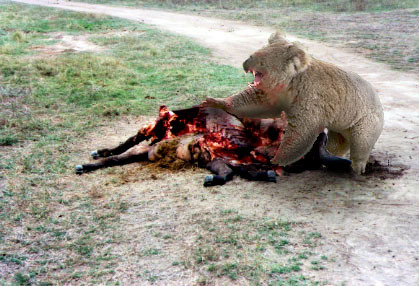The drop bear is typically described as "a large, vicious, carnivorous koala"2. It feeds on prey that tarry too long underneath eucalyptus trees. Just so people don't get it wrong, the regular koala (below) has been known to be violent, however it is usually docile.

The drop bear on the other hand is not. Drop bears will attack for no reason and will eat until there is nothing left of its prey.
Depending on where you may look, there are many ways of "preventing" drop bear attacks. It should be noted that none of them actually work, and are only designed by local Australians to watch as foreigners make fools of themselves. It is actually believed that these "prevention methods" actually make a person more succeptible to drop bear attacks as it is thought that the drop bear can tell whether a person is local or foreign as these methods usually result in a distinct scent from the person.
The drop bear is named specifically for how it attacks prey, by dropping down upon the prey and killing it. Throughout history the types of food has swung from everything and anything to more human oriented, with human orientation occurring in about 3 stages, 40 000 years ago, coinciding with the arrival of Aborigines to the continent; 1788 when Europeans first settled the continent, and from around 1970 to the present, with the increase in tourists. At present the most common tourist eaten by the drop bear is shared with the saltwater crocodile, the German3. The reason for this is due to the German being more likely to venture out of the drop bear free zones and into areas where drop bears are more plentiful.

Every year many Germans are killed by drop bears.
The picture to your right is a stylised version of a drop bear eating. It is about half way through its meal.
Note the similarities between the regular, docile koala, and the rarer, aggressive drop bear.
From the evidence it is thought that the drop bear follows a form of aggressive mimicry4, specifically Batsean-Wallacian as the koala, the less aggressive species, is the model. However, it is completely possible that the drop bear is just a sub-species of koala undergoing a speciation event.
It is quite possible that the drop bear may have evolved directly from Phascolarctos stirtoni5, also known as the Giant Koala. Remains of P. stirtoni have been found in the Naracoorte Caves6, and there possibility remains that the drop bear, is actually a descendent of the giant koala.
Due to the rarity of drop bears, coupled with the fact that they are pretty much exactly the same as a regular koala the DNA sequence of the drop bear has not been sequenced, so none of these hypotheses have been tested. It should be noted that the koala population of Kangaroo Island attests to this rarity, from the initial population of koalas that were brought to the island about 90 years ago, there has not been a single record of a drop bear attack.
Undoubtedly there is still plenty of research required to determine the origins of this remarkable species, however it must be stressed that the dangers of the drop bear is quite real.
2 comments:
hahahaha this is hilarious!
Post a Comment